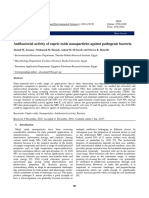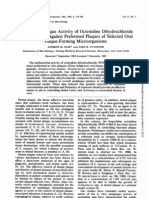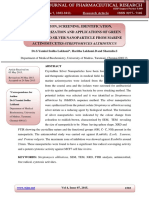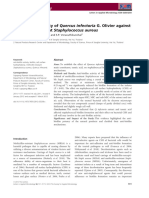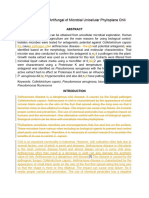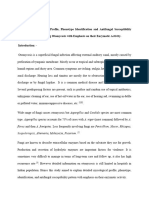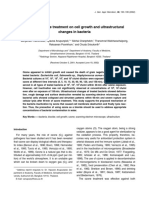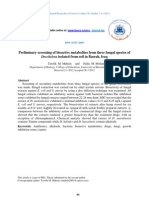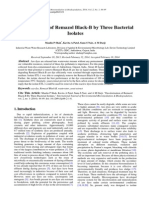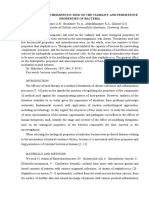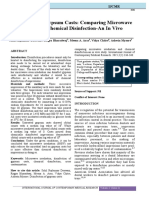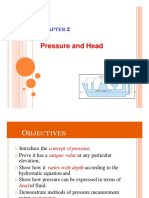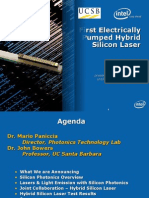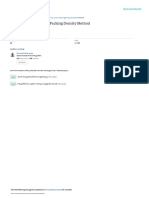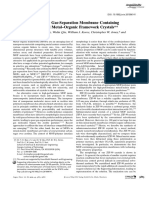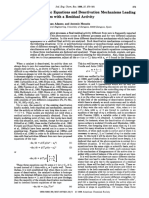Enzim
Enzim
Uploaded by
Khoirunnisa MuslimawatiCopyright:
Available Formats
Enzim
Enzim
Uploaded by
Khoirunnisa MuslimawatiOriginal Description:
Copyright
Available Formats
Share this document
Did you find this document useful?
Is this content inappropriate?
Copyright:
Available Formats
Enzim
Enzim
Uploaded by
Khoirunnisa MuslimawatiCopyright:
Available Formats
85
Document heading
In vitro antibacterial activity of the metal oxide nanoparticles against
urinary tract infectious bacterial pathogens
Sundaram Ravikumar
1*
, Ramasamy Gokulakrishnan
1
, Pandi Boomi
2
1
School of Marine Sciences, Department of Oceanography and Coastal Area Studies, Alagappa University, Thondi Campus, Thondi-623 409,
Ramanathapuram District, Tamil Nadu, India
2
School of Chemistry, Department of Industrial Chemistry, Alagappa University, Karaikudi-630 003, Sivgangai District, Tamil Nadu, India
Asian Pacific Journal of Tropical Disease (2012)85-89
Asian Pacific Journal of Tropical Disease
journal homepage:www.elsevier.com/locate/apjtd
*Corresponding author: Sundaram Ravikumar, School of Marine Sciences, Department
of Oceanography and Coastal Area Studies, Alagappa University, Thondi Campus,
Thondi-623 409, Ramanathapuram District, Tamil Nadu, India.
Tel: 04561-243470, +91-9003306959
E-mail: ravibiotech201321@gmail.com
Foundation Project: This work was financially supported by University Grants
Commission, New Delhi [grant No. F.No. 39-563/2010 (SR)].
1. Introduction
The infectious diseases remain one of the greatest
challenges to global health. Urinary tract infection (UTI) is
the second most common clinical disease and possesses a
significant healthcare burden
[1]
. This infectious disease can
alter the urinary system either structurally (complicated
UTI) or functionally. About 80 to 90 percent of UTIs are
caused by a single type of bacteria. Escherichia coli (E.
coli) is the most common cause of uncomplicated urinary
tracts (anatomically normal urinary tract). The diagnosis
of UTI is very difficult for the elder people because of the
asymptomatic bacteriuria
[2]
. So there is an urgent need
to produce the new antibacterial agents from different
sources. The terrestrial plant such as Phylanthus amarus
and Parquetina nigrescens showed potential antibacterial
activity against UTI pathogens
[3]
. Moreover, the marine
resources such as mangroves, seaweeds, sponges and sea
grasses already showed antibacterial
[4-8]
, antifungal
[6]
,
and antiplasmodial
[9-13]
activities. However, most of the
antibacterial agent entered into clinical practice, resistance
was reported in at least one bacterial pathogen
[14]
. During
the past decades, the nanoparticles are attracting a great
deal in biological and pharmaceutical applications
[15-18]
.
Moreover, the metal oxide nanoparticles have good
antibacterial activity and antimicrobial formulations
comprising nanoparticles could be used as an effective
bactericidal agent
[19-24]
. Nevertheless, studies related with
metal oxide nanoparticles against urinary tract infectious
pathogens are too limited. Hence, the present study has
been made an attempt to find out the potential nanoparticles
against urinary tract infectious pathogens.
ARTI CLE I NFO ABSTRACT
Article history:
Received 15 October 2011
Received in revised form 27 December 2011
Accepted 28 February 2012
Available online 28 April 2012
Keywords:
Antibacterial activity
Metal oxide nanoparticles
Minimum inhibitory concentration
Time kill assay
UTI pathogens
Minimal bactericidal concentration
Well diffusion method
Nanoparticle
Infectious bacterial pathogen
Objective: To investigate the antibacterial properties of the five metal oxide nanoparticles viz.,
Al
2
O
3
, Fe
2
O
3
, CeO
2
, ZrO
2
and MgO against urinary tract infectious pathogens viz., Pseudomonas
sp., Enterobacter sp., Klebsiella sp., Escherichia coli (E. coli), Proteus morganii (P. morganii)
and Staphylococcus aureus (S. aureus). Methods: The antibacterial activity of the five
different nanoparticles was assessed by well diffusion method. Different concentrations of the
nanoparticles were analyzed by minimal inhibitory concentration (MIC) and minimal bactericidal
concentration (MBC) techniques. Finally, the potential nanoparticle Al
2
O
3
which showed maximum
antibacterial sensitivity was also subjected for the time kill assay method. Results: Among the
nanoparticles, Al
2
O
3
nanoparticle showed maximum sensitivity (16.000.21) mm against E. coli.
None of the nanoparticles showed activity against Pseudomonas sp. The MIC results also revealed
that, the Al
2
O
3
nanoparticle showed maximum inhibition at the concentration of 5 g/mL against
E. coli, followed by 10 g/mL against Klebsiella sp. and P. morganii, respectively. Moreover, the
time kill assay revealed that, the bacterial growth was maximum inhibited at the concentration
of 5 g/mL from the 2nd h. Conclusions: It can be concluded from the present findings that,
the Al
2
O
3
nanoparticle can be used as an alternative antibacterial agent for the urinary bacterial
diseases after completing successful clinical trials.
Contents lists available at ScienceDirect
Sundaram Ravikumar et al./Asian Paicfic Journal of Tropical Disease (2012)85-89
86
2.1. Isolation of UTI bacterial pathogens
A total of 50 urine samples from 25 male and 25 female
patients admitted in the hospitals as UTI problems were
collected from different hospitals and laboratory localities
along the coastal area of Thondi, Ramanathapuram District,
Tamil Nadu, India (Lat. 944 N and Long. 7910E) in
a separate sterile wide mouth bottle. Before collecting a
sample, the women were instructed to swab the vulvae and
men to retract the foreskin and cleanse the glans penis.
Midstream urine was collected in a sterile wide mouthed
container. For the isolation of UTI bacterial strains, loop
full of urine samples were streaked into the nutrient agar,
Mac Conkey agar, blood agar and chocolate agar plates and
incubated at (372) for 24 h. Next day individual colonies
were selected and identified on the basis of morphological
characteristics, gram staining and biochemical characters
[25,26]
.
2.2. Antibacterial assay
The antibacterial activity of the chosen nanoparticles was
performed by using well diffusion method. About 20 mL of
sterile molten Mueller Hinton agar (HiMedia Laboratories
Pvt. Limited, Mumbai, India) was poured into the sterile
petriplates. Triplicates plates were swabbed with the
overnight culture (10
8
cells/mL) of pathogenic bacteria viz.,
Pseudomonas sp., Enterobacter sp., Klebsiella sp., E. coli,
Proteus morganii (P. morganii) and Staphylococcus aureus
(S. aureus). The solid medium was gently punctured with the
help of cork borer to make a well. Finally, the nanoparticle
samples (50 g/mL) were added from the stock into each
well and incubated for 24 h at (372) . After 24 h, the zone
of inhibition was measured and expressed as millimeter in
diameter.
2.3. Minimum inhibitory concentration (MIC)
About 500 L of different concentrations (2.5, 5, 10, 15 and
20 g) of chosen nanoparticles were prepared with dimethyl
sulphoxide (DMSO) and mixed with 450 L of nutrient broth
and 50 L of 24 h old bacterial inoculum and allowed to
grow overnight at 37 for 48 h. Nutrient broth alone served
as negative control. The MIC was the lowest concentration
of the nanoparticles that did not permit any visible growth
of bacteria during 24 h of incubation on the basis of
turbidity
[27]
.
2.4. Minimum bactericidal concentration (MBC)
To avoid the possibility of misinterpretations due to the
turbidity of insoluble compounds if any, the MBC was
determined by sub-culturing the above (MIC) serial dilutions
after 24 h in nutrient agar plates using 0.01 mL loop and
incubated at 37 for 24 h. MBC was regarded as the lowest
concentration that prevented the growth of bacterial colony
on this solid media
[27]
.
2.5. Time kill assay
The potential nanoparticle (Al
2
O
3
) which showed maximum
antibacterial activity against E. coli was also subjected for time
kill assay. The inoculum of E. coli (50 L) at a concentration
of (10
8
cells/mL) was mixed with 50 L (5 g concentration
of Al
2
O
3
) nanoparticle and the total volume was made
up to 5 mL by using minimal medium (g/L) [sucrose (10);
K
2
HPO
4
(2.5); KH
2
PO
4
(2.5); (NH
4
)
2
HPO
4
(1); MgSO
4
.7H
2
O (0.20);
FeSO
4
.7H
2
O (0.01); MnSO
4
.H
2
O (0.007) and H
2
O (1 000 mL)]. The
negative control was maintained without the nanoparticles.
The growth of the bacterial species was assessed at every 1 h
interval by measuring the optical density at 600 nm by using
spectrophotometer (Shimadzu, Japan)
[6]
.
3. Results
Out of the 60 midstream urine samples, 45 bacterial strains
were isolated and it was identified by using biochemical
tests (Table 2). Of these, Pseudomonas sp. is the predominant
one (38%), followed by Enterobacter sp. (22%), Klebsiella sp.
(18%), E. coli (11%), P. morganii (7%) and S. aureus (4%) (Figure
1). The zone of inhibition of the selected nanoparticles
against UTI pathogens was represented in Table 3. It
revealed that, the Al
2
O
3
nanoparticle showed maximum
sensitivity (16.000.21) mm against E. coli followed by (12.00
0.69) mm and (12.000.72) mm against Klebsiella sp. and
P. morganii, respectively. The MgO nanoparticle showed
maximum sensitivity (13.000.64) mm against E. coli and
showed minimum sensivity (9.000.29) mm against Klebsiella
sp. and P. morgonii (6.000.61) mm. The Fe
2
O
3
, Ceo
2
and ZrO
2
showed maximum sensitivity (10.000.35) mm against E. coli,
P. morganii (11.000.51) mm and Enterobacter sp. (12.00
0.26) mm, respectively. None of the nanoparticles showed
sensitivity against Pseudomonas sp. The MIC and MBC
revealed that, the Al
2
O
3
nanoparticle showed sensitivity at
the concentration of 5 g/mL against E. coli and Klebsiella
sp. and P. morganii 10 g/mL, respectively. Moreover,
MgO and ZrO
2
nanoparticles showed maximum sensitivity
against E. coli at the concentration of 10 g/mL, respectively
(Table 4). The effect of Al
2
O
3
nanoparticle against E. coli was
performed with time kill assay. It revealed that, the growth
2. Materials and methods
Commercial nanoparticles of Al
2
O
3
, Fe
3
O
4
, CeO
2
, ZrO
2
and
MgO were procured from Sigma Aldrich Company, India. The
characteristics of the nanoparticles are presented in Table 1.
Table 1
Properties of nanoparticles.
Formula Molecular weight Form Particle size (nm) (transmission electron microscope)
Al
2
O
3
101.96 Powder <50
Fe
3
O
4
231.53 Powder 9-11
CeO
2
172.11 Powder <25
ZrO
2
123.22 Powder <100
MgO 40.30 Powder <30
Sundaram Ravikumar et al./Asian Paicfic Journal of Tropical Disease (2012)85-89
87
of the pathogen was inhibited from the 2
nd
h when compared
with control (Figure 2).
11%
7%
4%
38%
18%
22%
Pseudomonas sp. Enterobacter sp. Klebsiella sp.
E. coli P. morganii S. aureus
Figure 1. Percentage occurrence and distribution of bacterial
pathogens in UTIs among the patients (n=45).
O
D
v
a
l
u
e
a
t
6
0
0
n
m
1.2
1
0.8
0.6
0.4
0.2
0
0 1 2 3 4 5 6 7 8 9 10 11 12
Time (h)
Figure 2. Time dependent assay of nanoparticle (Al
2
O
3
) against
chosen UTI pathogen E. coli.
Pathogen alone
Pathogen + Al
2
O
3
nanoparticle
4. Discussion
Nanotechnology is an emerging field and it has been
applied in science and technology for the purpose of
manufacturing new materials at the nanoscale level
[28]
. In
Table 2
Biochemical characterization of isolated bacteria from UTI patients.
Characteristics Pseudomonas sp. E. coli Klebsiella sp. Enterobacter sp. P. morganii S. aureus
Gram staining - - - - - +
TSI Slant K A A A K A
Butt K A A A A A
GAS - G G G G -
H
2
S - - - - - -
Mannitol Acid Acid Acid Acid - -
Motility Motile Motile Non-motile Motile Motile Motile
Indole test - - - - + -
Methyl red test + + - - + -
V.P. test - - + + - -
Citrate test - - + - - -
Urease test + - + - + -
Oxidase test + - - - - -
Catalase test + - - - + +
+: positive; -: negative; K: alkaline; A: acid; G: gas.
Table 3
Antibacterial activity of chosen 5 nanoparticles against UTI pathogens (meanSD) (mm) .
Name of
the nanoparticles
Pseudomonas sp. (n=17) Enterobacter sp. (n=10) Klebsiella sp. (n=8) E. coli (n=5) P. morganii (n=3) S. aureus (n=2)
Al
2
O
3
- - 12.000.69 16.000.21 12.000.72 9.000.61
Fe
2
O
3
- 7.000.23 - 10.000.35 - 7.000.67
Ceo
2
- 6.000.12 6.000.74 9.000.39 11.000.51 8.000.24
ZrO
2
- 12.000.26 7.000.45 10.000.59 - -
MgO - - 9.000.29 13.000.64 6.000.61 -
n: number of isolates; -: no sensitivity.
Table 4
MIC and MBC (
g/mL) of chosen 5 nanoparticles against UTI pathogens.
Name of the
nanoparticles
Pseudomonas
sp.
Enterobacter
sp.
Klebsiella sp. E. coli P. morganii S. aureus
MIC MBC MIC MBC MIC MBC MIC MBC MIC MBC MIC MBC
Al
2
O
3
- - - - 10 10 5 5 10 20 - -
Fe
2
O
3
- - - - - - 15 20 - - - -
Ceo
2
- - - - - - 20 20 20 20 - -
ZrO
2
- - 20 20 - - 10 20 - - - -
MgO - - - - 15 15 10 10 - - - -
-: no activity.
Sundaram Ravikumar et al./Asian Paicfic Journal of Tropical Disease (2012)85-89
88
the present scenario, the nanoparticles are being emerged as
novel antimicrobial agents with unique biological, chemical
and physical properties
[29,30]
. Moreover, the advantages of
the metal nanoparticles are less toxicity, heat resistance
and suitable for biological application
[19,31,32]
. All the
nanoparticles showed sensitivity against all the pathogens
except Pseudomonas sp. Of the selected nanoparticles, the
Al
2
O
3
nanoparticle showed maximum sensitivity against
E. coli. The MIC result reveals that, the Al
2
O
3
nanoparticle
showed maximum sensitivity at a concentration of 5 g/
mL against E. coli, 10 g/mL against Klebsiella sp. and P.
morganii, respectively and this activity might be due to the
size, surface morphology, particle morphology and structure
of the nanoparticles
[33]
and the possible mechanism for the
cell lyses is, the nanoparticles release ions which react with
the thiol (-SH) groups of protein present in the cell wall,
inactivate the protein and decrease the cell permeability
which leads to cellular death
[34]
. Earlier investigations
reveal that, the silver and gold nanoparticles showed various
biological properties
[35-54]
. Moreover, the TiO
2
and CdO,
Fe
3
O
4
and ZnO nanoparticles showed antibacterial activity
against E. coli
[34,55-57]
. Generally, the toxic effects of the
Al
2
O
3
nanoparticles are time dependent. This oxidative stress
in the cell wall might increase the production of lactate
dehydrogenase, which is an indicator of cell membrane
damage
[58]
. It is concluded from the present findings that,
the Al
2
O
3
nanoparticle could be used as an alternative
antibacterial agent for the urinary bacterial diseases after
completing successful clinical trials.
Conflict of interest statement
We declare that we have no conflict of interest.
Acknowledgements
The authors are thankful to the authorities of Alagappa
University for providing required facilities and also to
University Grants Commission, New Delhi for financial
assistance with the grant number: F.No.39-563/2010 (SR).
Reference
[1] Foxman B. The epidemiology of urinary tract infection. Nat Rev
Urol 2010; 7: 653-660.
[2] Barnett BJ, Stephens DS. Urinary tract infection: an overview. Am
J Med Sci 1997; 314(4): 245-249.
[3] Oluwafemi F, Debiri F. Antimicrobial effect of Phyllanthus
amarus and Parquetina nigrescens on Salmonella typhi. Afr J
Biomed Res 2008; 11: 215-219.
[4] Ravikumar S, Muthuraja M, Sivaperumal P, Gnanadesigan M.
Antibacterial activity of the mangrove leaves Exoecaria agallocha
against selected fish pathogens. Asian J Med Sci 2010; 2(5):
211-213.
[5] Ravikumar S, Thajuddin N, Suganthi P, Inbaneson SJ, Vinodkumar
T. Bioactive potential of seagrass bacteria against human
bacterial pathogens. J Environ Biol 2010; 31: 387-389.
[6] Ravikumar S, Ramanathan G, Subhakaran M, Inbaneson SJ.
Antimicrobial compounds from marine halophytes for silkworm
disease treatment. Int J Med Sci 2009; 1(5): 184-191.
[7] Ravikumar S, Gnanadesigan M, Suganthi P, Ramalakshmi A.
Antibacterial potential of chosen mangrove plants against isolated
urinary tract infectious bacterial pathogens. Int J Med Sci 2010;
2(3): 94-99.
[8] Sivaperumal P, Ramasamy P, Inbaneson SJ, Ravikumar S.
Screening of antibacterial activity of mangrove leaf bioactive
compounds against antibiotic resistant clinical isolates. World J
Fish Mar Sci 2010; 2(5): 348-353.
[9] Ravi kumar S, Ramanat han G, I nbaneson SJ, Ramu A.
Antiplasmodial activity of two marine polyherbal preparations
from Chaetomorpha antennina and Aegiceras corniculatum against
Plasmodium falciparum. Parasitol Res 2011; 108: 107-113.
[10] Ravikumar S, Inbaneson SJ, Suganthi P, Gnanadesigan M. In vitro
antiplasmodial activity of ethanolic extracts of mangrove plants
from South East coast of India against chloroquine-sensitive
Plasmodium falciparum. Parasitol Res 2011; 108: 873-878.
[11] Ravikumar S, Inbaneson SJ, Suganthi P, Venkatesan M, Ramu
A. Mangrove plants as a source of lead compounds for the
development of new antiplasmodial drugs from South East coast
of India. Parasitol Res 2011; 108: 1405-1410.
[12] Ravikumar S, Inbaneson SJ, Suganthi P, Gokulakrishnan R,
Venkatesan M. In vitro antiplasmodial activity of ethanolic
extracts of seaweed macroalgae against Plasmodium falciparum.
Parasitol Res 2011; 108: 1411-1416.
[13] Ravikumar S, Inbaneson SJ, Suganthi P. Seaweeds as a source of
lead compounds for the development of new antiplasmodial drugs
from South East coast of India. Parasitol Res 2011; 109: 47-52
[14] Laulloo SJ, Bhowon MG, Ravikumar S, Raja M, Gnanadesigan M,
Kalaiarasi A, et al. Antibacterial activity of schiff base ligands
containing pyridine and disulphide moieties against human
bacterial pathogens. J Phar Res 2010; 3(8): 2012-2014.
[15] Raffi M, Hussain F, Bhatti TM, Akhter JI, Hameed A, Hasan MM.
Antibacterial characterization of silver nanoparticles against E.
coli ATCC-15224. J Mater Sci Technol 2008; 24: 192-196.
[16] Krishnaraj C, Jagan EG, Rajasekar S, Selvakumar P, Kalaichelvan
PT, Mohan N. Synthesis of silver nanoparticles using Acalypha
indica leaf extracts and its antibacterial activity against water
borne pathogens. Colloids Surf B Biointerfaces 2010; 76(1): 50-56.
[17] Rai M, Yadav A, Gade A. Silver nanoparticles as a new generation
of antimicrobials. Biotechnol Adv 2009; 27: 76-83.
[18] Soltani M, Ghodratnema M, Ahari H, Mousavi HAE, Atee M,
Dastmalchi F, et al. The inhibitory effect of silver nanoparticles
on the bacterial fish pathogens, Streptococcus iniae, Lactococcus
garvieae, Yersinia ruckeri, and Aeromonas hydrophila. Int J Vet
Res 2009; 3(2): 137-142.
[19] Stoimenov PK, Klinger RL, Marchin GL, Klabunde KJ. Metal
oxide nanoparticles as bactericidal agents. Langmuir 2002; 18(17):
6679-6686.
[20] Ravikumar S, Gokulakrishnan R, Selvanathan K, Selvam S.
Antibacterial activity of metal oxide nanoparticles against
ophthalmic pathogens. Int J Pharm Res Dev 2011; 3(5): 122-127.
[21] Rajendran R, Balakumar C, Hasabo AMA, Jayakumar S, Vaideki
K, Rajesh EM. Use of zinc oxide nanoparticles for production of
antimicrobial textiles. Int J Eng Sci Technol 2010; 2(1): 202-208.
[22] Padmavathy N, Vijayaraghavan R. Enhanced bioactivity of ZnO
nanoparticles-an antimicrobial study. Sci Technol Adv Mater
Sundaram Ravikumar et al./Asian Paicfic Journal of Tropical Disease (2012)85-89
89
2008; 9: 7.
[23] Hosseinkhani P, Zand AM, Imani S, Rezayi M, Zarchi SR.
Determining the antibacterial effect of ZnO nanoparticle against
the pathogenic bacterium, Shigella dysenteriae (type 1). Int J
Nano Dimens 2011; 1(4): 279-285.
[24] Sunita J, Suresh G, Madhav N, Anjali R. Copper oxide
nanoparticles: synthesis, characterization and their antibacterial
activity. J Clust Sci 2011; 22(2): 121-129.
[25] Thomas JG. Urinary tract infections. In: Mahon CR, Manuselis
G. (eds.) Diagnostic microbiology. Philadelphia: W.B. Saunders
Company; 1995, p. 950-969.
[26] Brough MC. Bacterial pathogens. In: Cheesbrough M. (ed.) District
laboratory practice in tropical countries. London: Cambridge
University Press; 2000, p. 157-234.
[27] Hammond SM, Lambert PA. Antimicrobial actions. London:
Edward Arnld Ltd; 1978, p. 8-9.
[28] Albrecht MA, Evan CW, Raston CL. Green chemistry and the
health implications of nanoparticles. Green Chem 2006; 8: 417-432.
[29] Morones JR, Elechiguerra JL, Camacho A, Holt K, Kouri JB,
Ramrez JT, et al. The bactericidal effect of silver nanoparticles.
Nanotechnology 2005; 16(10): 2346-2353.
[30] Kim JS, Kulk E, Yu KN, Kim JH, Park SJ, Lee HJ, et al.
Antimicrobial effects of silver nanoparticles. Nanomedicine 2007;
3: 95-101.
[31] Prasad R, Gaurav R. Preparation methods and applications of
CuO-CeO
2
catalysts: a short review. Bull Chem React Eng Catal
2010; 5(1): 7-30.
[32] Brayner R, Ferrari-Iliou R, Brivois N, Djediat S, Benedetti MF,
Fievet F. Toxicological impact studies based on Escherichia coli
bacteria in ultrafine ZnO nanopartiocles colloidal medium. Nano
Lett 2006; 6: 866-870.
[33] Ramesh RP, Okigbo RN, Madhusoodhan SA, Sangeeta C.
Nanotechnology importance in the pharmaceutical industry. Afr J
Pure Appl Chem 2008; 2(3): 27-31.
[34] Zhang H, Chen G. Potent antibacterial activities of Ag/TiO2
nanocomposite powders synthesized by a one-pot sol-gel
method. Environ Sci Technol 2009; 43(8): 2905-2910.
[35] Inbaneson SJ, Ravikumar S, Manikandan N. Antibacterial
potential of silver nanoparticles against isolated urinary tract
infectious bacterial pathogens. Appl Nanosci 2011; 1: 231-236.
[36] Baker C, Pradhan A, Paktis L, Pochan DJ, Shah SI. Synthesis and
antibacterial properties of silver nanoparticles. J Nanosci Technol
2005; 5: 244-249.
[37] Martinez-Castanon GA, Nino-Martinez N, Martinez-Gutierrez F,
Martinez-Mendoza JR, Ruiz F. Synthesis and antibacterial activity
of silver nanoparticles with different sizes. J Nanopart Res 2008;
10: 1343-1348.
[38] Tripathi A, Chandrasekaran N, Raichur AM, Mukherjee A.
Antibacterial applications of silver nanoparticles synthesized by
aqueous extract of Azadirachta indica (Neem) leaves. J Biomed
Nanotechnol 2009; 5(1): 93-98.
[39] Sondi I, Sondi S. Silver nanoparticles as antimicrobial agents:
a case study on E. coli as a model Gram-negative bacteria. J
Colloid Interface Sci 2004; 275: 177-182.
[40] Prasad TNVKV, Elumalai EK. Biofabrication of Ag nanoparticles
using Moringa oleifera leaf extract and their antimicrobial
activity. Asian Pac J Trop Biomed 2011; 1(6): 439-443.
[41] Mukunthan KS, Elumalai EK, Patel TN, V Ramachandra Murty.
Catharanthus roseus: a natural source for the synthesis of silver
nanoparticles. Asian Pac J Trop Biomed 2011; 1: 270-274.
[42] Chakraborty SP, Mahapatra SK, Sahu SK, Pramanik P, Roy S.
Antioxidative effect of folatemodified chitosan nanoparticles.
Asian Pac J Trop Biomed 2011; 1: 29-38.
[43] Nabikhan A, Kandasamy K, Raj A, Alikunhi NM. Synthesis of
antimicrobial silver nanoparticles by callus and leaf extracts
from saltmarsh plant Sesuvium portulacastrum L. Colloids Surf B
Biointerfaces 2010; 79: 488-493.
[44] Saxena A, Tripathi RM, Singh RP. Biological synthesis of silver
nanoparticles by using onion (Allium cepa) extract and their
antibacterial activity. Digest J Nanomater Biostruct 2010; 5(2):
427-432.
[45] Gnanadesigan M, Anand M, Ravikumar S, Maruthupandy
M, Vijayakumar V, Selvam S, et al. Biosynthesis of silver
nanoparticles by using mangrove plant extract and their potential
mosquito larvicidal property. Asian Pac J Trop Med 2011; 4: 799-803.
[46] Gnanadesigan M, Anand M, Ravikumar S, Maruthupandy M,
Syed Ali M, Vijayakumar V, et al. Antibacterial potential of
biosynthesised silver nanoparticles using Avicennia marina
mangrove plant. Appl Nanosci 2011.
[47] Cho K, Park J, Osaka T, Park S. The study of antimicrobial activity
and preservative effects of nanosilver ingredient. Electrochim
Acta 2005; 51: 956-960.
[48] Elumalai EK, Prasad TNVKV, Hemachandran J, Therasa
SV, Thirumalai T, David E. Extracellular synthesis of silver
nanoparticles using leaves of Euphorbia hirta and their
antibacterial activities. J Pharm Sci Res 2010; 2(9): 549-554.
[49] Sathishkumar M, Sneha K, Won SW, Cho CW, Kim S, Yun YS.
Cinnamon zeylanicum bark extract and powder mediated green
synthesis of nano-crystalline silver particles and its bactericidal
activity. Colloids Surf B Biointerfaces 2009; 73(2): 332-338.
[50] Padma SV, Dhara S. Biosynthesis of silver nanoparticles using
lemon leaves extract and its application for antimicrobial finish
on fabric. Appl Nanosci 2011.
[51] Ameer A, Faheem A, Nishat A, Chaman M, Naqvi AH. One step
synthesis and characterization of gold nanoparticles and their
antibacterial activities against E. coli (ATCC 25922 strain). Int J
Theor Appl Sci 2009; 1(2): 1-4.
[52] Sperling AR, Gil RP, Zhang F, Zanella M, Parak JW. Biological
application of gold nanoparticles. Chem Soc Rev 2008; 37:
1896-1908.
[53] Liau SY, Read DC, Pugh WJ, Furr JR, Russell AD. Interaction of
silver nitrate with readily identifiable groups: relationship to the
antibacterial action of silver ions. Lett Appl Microbiol 1997; 25(4):
279-283.
[54] Burygin GL, Khlebtsov BN, Shantrokha AN, Dykman LA,
Bogatyrev VA, Khlebtsov NG. On the enhanced antibacterial
activity of antibiotics mixed with gold nanoparticles. Nanoscale
Res Lett 2009; 4: 794-801.
[55] Saeed RZ, Aisha J, Madiha JG, Soufian S, Firouzabadi FB,
Moghaddam AB, et al. Comparative study of antimicrobial
activities of TiO
2
and CdO nanoparticles against the pathogenic
strain of Escherichia coli. Iran J Pathol 2010; 5(2): 83-89.
[56] Fu G, Vary PS, Lin C. Anatase TiO
2
nanocomposites for
antimicrobial coatings. J Phys Chem B 2005; 109(18): 8889-8898.
[57] Gong P, Li H, He X, Wang K, Hu J, Tan W, et al. Preparation and
antibacterial activity of Fe
3
O
4
@Ag nanoparticles. Nanotechnology
2007; 18: 604-611.
[58] Weisheng L, Huang YW, Zhou XD, Ma Y. Toxicity of cerium oxide
nanoparticles in human lung cancer cells. Int J Toxicol 2006; 25(6):
451-457.
You might also like
- H432 02 Mark Scheme Set 1Document27 pagesH432 02 Mark Scheme Set 1JeronNo ratings yet
- Antibacterial Activity of Cupric Oxide Nanoparticles Against Pathogenic BacteriaDocument4 pagesAntibacterial Activity of Cupric Oxide Nanoparticles Against Pathogenic BacteriaNILTHON FRANCO POMA HUARINGANo ratings yet
- Isolation and Characterization of Actinomycetes From Soil and Evaluation of Antibacterial Activities of Actinomycetes Against PathogensDocument9 pagesIsolation and Characterization of Actinomycetes From Soil and Evaluation of Antibacterial Activities of Actinomycetes Against PathogensTrương Tấn SangNo ratings yet
- Medical MicrobiologyDocument18 pagesMedical MicrobiologyHemant vermaNo ratings yet
- DocumentDocument10 pagesDocumentJayNo ratings yet
- Review Note On The Application of Metagenomics in Emerging Aquaculture Systems and Aquatic Animal Health ManagementDocument8 pagesReview Note On The Application of Metagenomics in Emerging Aquaculture Systems and Aquatic Animal Health ManagementEditor IJIRMFNo ratings yet
- Anti CandidaDocument8 pagesAnti CandidasivarajNo ratings yet
- Biogenic Silver Nanoparticles Synthesis Characterization and Its Potential Against Cancer Inducing Bacteria - 2016 - Journal of Molecular LiquidsDocument10 pagesBiogenic Silver Nanoparticles Synthesis Characterization and Its Potential Against Cancer Inducing Bacteria - 2016 - Journal of Molecular LiquidsCINDY VANESSA RESTREPO BURGOSNo ratings yet
- Shinde Et Al. - 2021 - Synthesis of Chitosan Coated Silver Nanoparticle Bioconjugates and Their Antimicrobial Activity Against MultidDocument18 pagesShinde Et Al. - 2021 - Synthesis of Chitosan Coated Silver Nanoparticle Bioconjugates and Their Antimicrobial Activity Against MultidRevathi RajagopalNo ratings yet
- Efficacy of Different Concentrations of Sodium Hypochlorite and Chlorhexidine in Disinfection of Contaminated Resilon ConesDocument4 pagesEfficacy of Different Concentrations of Sodium Hypochlorite and Chlorhexidine in Disinfection of Contaminated Resilon ConesLuis Pacheco RamirezNo ratings yet
- 9Document3 pages9kicklokickNo ratings yet
- Using Silver Nano-Particles To Increase Efficiency of Sterile Solution For in Vitro TechniquesDocument4 pagesUsing Silver Nano-Particles To Increase Efficiency of Sterile Solution For in Vitro Techniquesargos1301No ratings yet
- Octenidine DihydrochlorideDocument6 pagesOctenidine Dihydrochlorideketan79797No ratings yet
- Resistance Profile of Bacteria Isolated From Surfaces and Staffs Hands in Bacteriology Laboratories in Togo 2021Document5 pagesResistance Profile of Bacteria Isolated From Surfaces and Staffs Hands in Bacteriology Laboratories in Togo 2021Scivision PublishersNo ratings yet
- 10marine Nano Taramani2015Document20 pages10marine Nano Taramani2015Gouse BashaNo ratings yet
- 3018-Article Text-3670-4-10-20160408Document5 pages3018-Article Text-3670-4-10-20160408Gouse BashaNo ratings yet
- ATENÇÃOOOOOOOOOOOODocument7 pagesATENÇÃOOOOOOOOOOOOIandra de Assis SilvaNo ratings yet
- Synthesis, Characterization and Antibacterial Activity of Aluminium Oxide NanoparticlesDocument4 pagesSynthesis, Characterization and Antibacterial Activity of Aluminium Oxide NanoparticlesArka GhoshNo ratings yet
- Cu WS Nanocrystals For Photocatalytic Inhibition of StaphylococcusDocument21 pagesCu WS Nanocrystals For Photocatalytic Inhibition of StaphylococcusM Arfat YameenNo ratings yet
- 810-Article Text-3146-1-15-20220801Document20 pages810-Article Text-3146-1-15-20220801Wildan AinurrahmanNo ratings yet
- Synopsis MBDocument7 pagesSynopsis MBjohndhaliwal99No ratings yet
- Amar RatanDocument7 pagesAmar RatanER Publications, IndiaNo ratings yet
- 48 193-OzoneDocument7 pages48 193-OzoneHuỳnh Tấn NhựtNo ratings yet
- Contribution to optimization and standardization of antibacterial assays with silver nanoparticlesDocument7 pagesContribution to optimization and standardization of antibacterial assays with silver nanoparticlesmicrobehunter007No ratings yet
- Preliminary Screening of Bioactive Metabolites From Three Fungal Species ofDocument10 pagesPreliminary Screening of Bioactive Metabolites From Three Fungal Species ofdhyantiNo ratings yet
- 2 PB PDFDocument9 pages2 PB PDFmuh. saanNo ratings yet
- Bacteria-Mediated Green Synthesis of Silver Nanoparticles and Their Antifungal Potentials Against Aspergillus Flavus - PLOS ONEDocument19 pagesBacteria-Mediated Green Synthesis of Silver Nanoparticles and Their Antifungal Potentials Against Aspergillus Flavus - PLOS ONEshaarifhamzaNo ratings yet
- Research Article: Isolation, Characterization, and Screening of Antimicrobial-Producing Actinomycetes From Soil SamplesDocument7 pagesResearch Article: Isolation, Characterization, and Screening of Antimicrobial-Producing Actinomycetes From Soil SamplesNatalija Atanasova-PancevskaNo ratings yet
- Abdi Et Al. 2008Document6 pagesAbdi Et Al. 2008argos1301No ratings yet
- Praktikum 3Document15 pagesPraktikum 3Galuh Novita AyuNo ratings yet
- 2019sàng lọc nhanh kháng sinh đa dư lượng trong cơ từ cácc loài động vật khác nhau bằng phương pháp ức chế vi sinh.Document6 pages2019sàng lọc nhanh kháng sinh đa dư lượng trong cơ từ cácc loài động vật khác nhau bằng phương pháp ức chế vi sinh.Đào Ngô Tú QuỳnhNo ratings yet
- Antimicrobial Activity of Antibiotic ProDocument5 pagesAntimicrobial Activity of Antibiotic ProFIRDA TRYANANo ratings yet
- Antimicrobial Activity of Antibiotic Pro PDFDocument5 pagesAntimicrobial Activity of Antibiotic Pro PDFFIRDA TRYANANo ratings yet
- Label-Free Electrochemical Biosensor Based On Au@Mos - Pani For Escherichia Coli DetectionDocument12 pagesLabel-Free Electrochemical Biosensor Based On Au@Mos - Pani For Escherichia Coli Detectiontuyenbany16102002No ratings yet
- Petlamul 2012Document7 pagesPetlamul 2012roseNo ratings yet
- Isolation and Characterization of Potential Probiotic Escherichia Coli Strains From Rat Faecal SamplesDocument7 pagesIsolation and Characterization of Potential Probiotic Escherichia Coli Strains From Rat Faecal Samplesada-adutzaNo ratings yet
- Heliyon: Tooraj Mehdizadeh, Asghar Zamani, Seyyed Meysam Abtahi FroushaniDocument6 pagesHeliyon: Tooraj Mehdizadeh, Asghar Zamani, Seyyed Meysam Abtahi FroushaniAndreea NeculaNo ratings yet
- JM Pharmacon,+22.+zulkiflihamzahDocument8 pagesJM Pharmacon,+22.+zulkiflihamzahfilosofi kopiNo ratings yet
- 2004 SawaiDocument7 pages2004 SawaiRodolfo Angulo OlaisNo ratings yet
- P.Dhasarathan and A J A RanjitsinghDocument29 pagesP.Dhasarathan and A J A RanjitsinghranjitsinghNo ratings yet
- Fakhrfeshani Et Al 2012Document7 pagesFakhrfeshani Et Al 2012argos1301No ratings yet
- TMP 9 ADBDocument6 pagesTMP 9 ADBFrontiersNo ratings yet
- tmp16EB TMPDocument5 pagestmp16EB TMPFrontiersNo ratings yet
- Kaajal PDFDocument3 pagesKaajal PDFpvnchemNo ratings yet
- Skowron2018 Article ComparisonOfSelectedDisinfectaDocument11 pagesSkowron2018 Article ComparisonOfSelectedDisinfectaFlorentina BucurNo ratings yet
- Nanotechnology in MedicineDocument8 pagesNanotechnology in Medicinerully1234No ratings yet
- tmp8D22 TMPDocument3 pagestmp8D22 TMPFrontiersNo ratings yet
- Silver Nanoparticles From A Plant Echinacea Purpurea Extract For Its Antipathogenic EfficacyDocument3 pagesSilver Nanoparticles From A Plant Echinacea Purpurea Extract For Its Antipathogenic EfficacyEditor IJTSRDNo ratings yet
- 03 CJB 003 Prem SynthesisDocument12 pages03 CJB 003 Prem SynthesisSumera ShaikhNo ratings yet
- Edit-Manuscript Ver 3Document22 pagesEdit-Manuscript Ver 3Putri BernawatiNo ratings yet
- 10.1.1.506.6811Document4 pages10.1.1.506.6811reponsible personNo ratings yet
- Antimicrobial Activity of Different Tissues of Snakehead Fish Channa Striatus (Bloch)Document4 pagesAntimicrobial Activity of Different Tissues of Snakehead Fish Channa Striatus (Bloch)alem010No ratings yet
- crmb725 732 PDFDocument9 pagescrmb725 732 PDFrababNo ratings yet
- Long Chain N-Acyl Homoserine Lactone Production by Enterobacter SP Isolated From Human Tongue SurfacesDocument8 pagesLong Chain N-Acyl Homoserine Lactone Production by Enterobacter SP Isolated From Human Tongue SurfacesUniversity Malaya's Dental Sciences ResearchNo ratings yet
- Des InfectionDocument5 pagesDes InfectionCatatan BersajakNo ratings yet
- A Low-Tech Bioreactor System For The Enrichment and Production of Ureolytic MicrobesDocument8 pagesA Low-Tech Bioreactor System For The Enrichment and Production of Ureolytic MicrobesAfshaNo ratings yet
- Nigrum and Study of Its Antibacterial Effect Against Common Nosocomial PathogensDocument22 pagesNigrum and Study of Its Antibacterial Effect Against Common Nosocomial Pathogensosama almomaniNo ratings yet
- Handbook for Microbiology Practice in Oral and Maxillofacial Diagnosis: A Study Guide to Laboratory Techniques in Oral MicrobiologyFrom EverandHandbook for Microbiology Practice in Oral and Maxillofacial Diagnosis: A Study Guide to Laboratory Techniques in Oral MicrobiologyNo ratings yet
- Fan Inlet System EffectsDocument4 pagesFan Inlet System EffectsEzrizal Yusuf100% (1)
- Gujarat Forensic Sciences University: Specification of RCCDocument36 pagesGujarat Forensic Sciences University: Specification of RCCMadhav PurohitNo ratings yet
- Chapter 2-Pressure and HeadDocument54 pagesChapter 2-Pressure and Headhesham helalyNo ratings yet
- ET de TubulacaoDocument214 pagesET de TubulacaoClarisse MendoncaNo ratings yet
- Magnesium CarbonatetDocument3 pagesMagnesium CarbonatetmarctcNo ratings yet
- Ionic EquilibriaDocument64 pagesIonic EquilibriaArima KouseiNo ratings yet
- From Molten Materials To RocksDocument3 pagesFrom Molten Materials To RocksDanica Banatao Attaban100% (1)
- Mech. Design (Sizing)Document12 pagesMech. Design (Sizing)Alaa Ramadan100% (1)
- MSL Technical Guide 11 Thermometer Immersion and Dry-Block CalibratorsDocument3 pagesMSL Technical Guide 11 Thermometer Immersion and Dry-Block CalibratorsPrabath De SilvaNo ratings yet
- Steam TurbineDocument56 pagesSteam Turbinegirish_nonie77% (26)
- Task 1 CompletedDocument112 pagesTask 1 CompletedAdawiyah Az-zahraNo ratings yet
- First Electrically Pumped Hybrid Silicon LaserDocument27 pagesFirst Electrically Pumped Hybrid Silicon LaserSuneeldatta KolipakulaNo ratings yet
- Science: Quarter 2, Wk.2-M2Document43 pagesScience: Quarter 2, Wk.2-M2Ericha Solomon76% (21)
- Audible & Vibratory Pavement MarkingDocument4 pagesAudible & Vibratory Pavement MarkingRoslan 'Abok' KamarudinNo ratings yet
- Concrete Mix Design by Packing Density Method: January 2014Document14 pagesConcrete Mix Design by Packing Density Method: January 2014binodNo ratings yet
- Reid Vapor Pressure RVPDocument10 pagesReid Vapor Pressure RVPtimsykiNo ratings yet
- A High Performance Gas Separation Membrane Containing Submicrometer Sized MetalDocument4 pagesA High Performance Gas Separation Membrane Containing Submicrometer Sized MetalAdam MNo ratings yet
- Some Intrinsic Kinetic Equations and Deactivatioll Mechanisms Leading To Deactivation Curves With A Residual Activity Corella1988Document7 pagesSome Intrinsic Kinetic Equations and Deactivatioll Mechanisms Leading To Deactivation Curves With A Residual Activity Corella1988Jose NNo ratings yet
- Production of CumeneDocument16 pagesProduction of CumeneSaidNo ratings yet
- Electrical Discharge Machining of Al 6351 SiC B4C Hybrid CompositeDocument7 pagesElectrical Discharge Machining of Al 6351 SiC B4C Hybrid CompositeAnonymous EU3yPnqvNo ratings yet
- Nomenclature of EthersDocument3 pagesNomenclature of EthersLala SopiohNo ratings yet
- Emission Regulations Part-ThreeDocument84 pagesEmission Regulations Part-ThreeGanesh DivekarNo ratings yet
- The Secret of ScentDocument219 pagesThe Secret of Scentjenbreault95% (21)
- Ocean Loading in Ansys 14.5Document29 pagesOcean Loading in Ansys 14.5Phúc Phan Tử100% (1)
- Training On CCA and SCAL Experiments: 1. OverviewDocument18 pagesTraining On CCA and SCAL Experiments: 1. OverviewWahid MiaNo ratings yet
- CEMENT Types-3Document19 pagesCEMENT Types-3Fran JimenezNo ratings yet
- Ink Characterizationand Dating AnalysisDocument27 pagesInk Characterizationand Dating Analysisanthony magandaNo ratings yet
- Day 29: Mechanical Behavior of PolymersDocument24 pagesDay 29: Mechanical Behavior of Polymersmailnewaz9677No ratings yet
- Module 2 (Atomic Structure and Interatomic Bonding)Document26 pagesModule 2 (Atomic Structure and Interatomic Bonding)Ralph Andrew Silverio100% (4)

